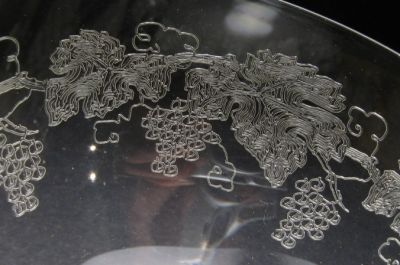|
|
|
Pantograph etching
|
Pantograph etching is done with a template larger than the design itself. The operator moves a stylus along the pattern, and the pantograph machine transfers that movement to a needle. The needle scratches the pattern into a resist (such as beeswax) that protects the glass from the effects of acid. The object is dipped in acid, and wherever the needle has scratches, it is etched.
Pantograph etching is easily confused with plate (transfer) etching. Pantograph designs often contain very long lines twisted into shapes that give the overall impression of solidly etched areas. The lines are the same width and depth throughout, and there are no missing areas, as often happens in plate etching. Pantograph etching can be distinguished from needle etching by the presence of dead-end lines.
|
|












